UMD Gives Concordia Toughest Test
By John Gilbert
There might be better rivalries in collegiate sports than the one between Minnesota-Duluth and Concordia of St. Paul in women’s volleyball. But it’s hard to imagine one in Minnesota sports. The Concordia Golden Bears won an incredible seventh consecutive NCAA Division II volleyball championship in December, an honor they gained by wresting the Central Regional championship match from the Bulldogs in a four-game battle.
Expectations were high for UMD’s volleyball team, which earned the right to play host to the NCAA Division II Central Regional tournament by capping a fantastic season with a pair of victories over Concordia. First, UMD beat the Golden Bears in a five-game match to end the regular Northern Sun Intercollegiate Conference season.

Concordia’s Riley Hanson blocked a kill attempt by UMD’s Kate Lange, and her Bulldog teammate Ashley Hinsch reflected the despair.
The road got tougher when the Bulldogs had to win an NSIC playoff opener at home to reach the league playoff semifinals and final at Concordia, where the Golden Bears are virtually unbeatable. But the Bulldogs pulled it off, winning in the semifinals and then stunning Concordia in three straight games for the league playoff title.
Riding that hot streak that counted 10 consecutive games from the final regular season game through the three sweeps of the league playoffs, and that gave UMD the home court advantage as host to the Central Regional. Once there, UMD proved it belonged by sweeping past Arkansas Tech, then Southwest Minnesota State, while Concordia got back in the groove by beating Northern State and Central Missouri.
That put the Golden Bears into the Central Region final against UMD. At stake was a slot in the eight-team NCAA D-II tournament. UMD came in 33-2, having lost only an early match to Concordia at Concordia, and a late-season match against Northern State, while Concordia’s six-straight national championship streak was under siege, but the Golden Bears brought a 31-3 record into the match, with two of the three victories inflicted by the Bulldogs.
It figured to be a match of two of the nation’s best teams, because after No. 1 ranked Tampa, UMD was No. 2 and Concordia No. 3 — in the country, let alone the league or the region.
While UMD was loaded with power-hitting Kate Lange and a very strong supporting cast, Concordia has an incredibly balanced team, with every player seeming capable of every act required of volleyball specialists. Without question, the Golden Bears would be the constant, and it was up to the Bulldogs to return to the amazing peak they had attained in their two most recent battles with Concordia.
It was clear that Concordia was at its best, trading attacks with the Bulldogs from the start, and escaping with a 25-17 first game victory. It was 16-14 late in the game when the Golden Bears came up with a series of blocks that derailed the Bulldogs, running off five straight points to go from 16-14 to 21-14, and Concordia won a vital first game.
UMD stormed back in Game 2, with Lange at her best and her teammates rallying with her for a 25-20 victory. It was a tough game, standing 13-13 until Lange led a charge for four straight points, and a commanding lead. When it was 16-13, Lange, as powerful and explosive a hitter as there is in Division II volleyball, blasted one cannon shot that struck a Concordia player crouching down in the back row trying to block, and the ricochet shot off to the right and landed in Row 4.
It appeared that if the teams played evenly, the match would come down to how well Concordia could cope with Lange’s power. In Game 3, Concordia got the early lead but Lange got free to gain ties at 13-13 and 14-14. But then Concordia’s flawless hitting balance and skill gained four straight points, and the Golden Bears held firmly for a 25-21 triumph.
That put Concordia up 2-1, and UMD would have to win Game 4 in order to avoid the end of its season and force the final to a deciding fifth game.
Concordia ruined those plans by jumping ahead 5-1. From there, the game evolved into a mighty struggle for the Bulldogs to catch up, then fall behind, then catch up again. Trailing 10-5, UMD put on a stirring rally by winning six of the next seven points, with another Lange blast gaining an 11-11 deadlock. While it was far from a one-hitter charge, Lange rose above all for kills that also provided 12-1`2, 13-13, and 14-14 ties, and the Bulldogs also evened the game at 15-all. But then it was Concordia’s turn to score six of the next seven points, with a block point making it 21-16.
Game 4 wound up 25-20 for Concordia, making it the end of a splendid 33-3 UMD season, and the end of Lange’s record-shattering career — but not before she registered 24 kills in the title match — and sending the Golden Bears to their chance at a seventh consecutive national championship with a 32-3 record.
In the array of intercollegiate sports teams at UMD, volleyball falls in there someplace behind Division I men’s hockey, Division I women’s hockey, and Division II football, and in a lot of years it might find men’s and women’s basketball, baseball and softball battling it for “second tier” prominence.
But not this season. This season, football had a fantastic run to the national tournament’s second round, and men’s hockey is stirring up new interest in its new National Collegiate Hockey Conference. But women’s volleyball is right up there with the best and most entertaining sports on campus. When the current season just ended with a three games to one loss to six-time defending NCAA Division II Concordia of St. Paul, the Bulldogs had thoroughly entertained a crowd of 1,700 — win or lose. Of course, the Bulldogs won more than they lost, dropping only one home-court match at Romano Gym, to Northern State, before falling to Concordia.
UMD coach Jim Boos congratulated the Golden Bears, and his own team. “I’m proud of how hard we played,” he said. “We just got outplayed by a team that just played better. They made only nine hitting errors all night. I’m proud of our effort, and our energy level, and we had a tremendous year, with all the records and awards, but they just weren’t making any mistakes.”
Kate Lange, who set the all-time UMD record for career kills early in the season, finished with 24 kills on 59 attempts — both nearly twice as many as any other player on either team. “It was awesome to have all those fans behind us,” said Lange. “For sure, we battled back, and if we hadn’t dug such a hold for ourselves, we probably could have done even better.”
Lange got emotional then. “I kinda felt it was our night, until it was over,” she said. “It’s crazy it’s over already…I wouldn’t have played anywhere else.”
Concordia coach Brady Starkey is legendary for his casual approach. He has his team so plugged in that his players are always upbeat, never seeming to notice, or show, any effects of pressure. “Volleyball, and sports, are supposed to be fun,” said Starkey. “The games are much easier when everybody takes a light approach and is enjoying it.
“When they beat us 3-0, it was a good match. Our girls realized that if we don’t come to play in the final, what could happen. We played very efficient and clean and it was a total team effort. We got blocks when we needed them, we covered, we scrapped, and we got through some long rallies. We did a good job of taking what we could, and we got good touches to slow them down.”
Kayla Koenecke, a senior from Delano, has now played in — and won — regional and national championships every year. She’ll be trying for her fourth while the Golden Bears will be striving for their seventh. I asked he if she could ever envision Concordia losing in this Central Regional final. “No, I can’t ever envision that,” she said. “We enjoyed every point, because four years is too short, and you never know when you might have your last game together.”
Lange capped her senior season by being named first-team All-America, and then won the Division II volleyball player of the year award.
Hibbert Flies Past SnoCross Foes
By John Gilbert
It’s understandable pro snowcross racers aren’t satisfied when they lose, but Tucker Hibbert is the top pro snowmobile racer on the planet because he is more demanding than the normal racer. “I’m not always satisfied when I win,” Hibbert said at Spirit Mountain before last weekend’s AMSOIL Championship — the season-opening race on the 9-race 2013-14 schedule.
But after a slow start, Hibbert was definitely satisfied after sweeping both Pro Open feature races Saturday and Sunday. Not that it started out smoothly. Hibbert, who has won seven Snowcross championships but failed to win either last season or the season before at Spirit Mountain, went out on the creatively challenging jumps and hills carved into the top of Spirit Mountain and promptly had a problem in the match-race dominator competition Friday night. He came back to not only win Saturday night’s feature, but he lapped the entire field in the process.
On Sunday afternoon, with a large and enthusiastic crowd in the stands and spilling out of the chalet, Hibbert’s Arctic Cat was beaten off the starting surge by Kyle Pallin’s Polaris, and after they hopped, leaped and churned up the backside and came around the top of the course, Hibbert caught up. When they came past the finish line, Hibbert took the inside line and actually made the pass on Pallin as the two flew through the air and landed at the bottom turn.
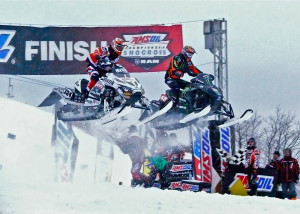
There was a difference between the first and last laps of the AMSOIL SnoCross feature at Duluth’s Spirit Mountain. On the first lap, left, Tucker Hibbert made a flying pass of early leader Kyle Palliln; on the last lap, Hibbert was alone with the checkered flag.
From there, Hibbert made no mistakes, cruising to the victory that gave him a sweep of the weekend’s two Pro Open features and capped the weekend that also saw Pro Lites, Amateur, Women, and Junior Novice classes. The top two categories are the Pro Lites, for stock 600 cc. engines, and the Pro Open for modified, highly sophisticated 600s.
In Minnesota, Arctic Cats, which are made in Thief River Falls, and Polaris, which are made in Roseau, are the homestate favorites, but Canada’s Bombardier Ski-Doo machines, and the new Yamaha racers offer more competition. Hibbert, who now lives in Pelican Rapids, MN., grew up in Thief River Falls, and, naturally, has raced Arctic Cats since he started racing semi-pro, and turned to Pro in 2001.
“We have a 600 cc. two-stroke engine displacement limit, and Arctic Cat uses Suzuki engines,” said Hibbert. “We can make modifications to the oompression ratio and exhaust, and we make a lot of mods to the chassis and suspension.”
Year-round workouts, including motocross motorcycles in the summertime, keep riders like Hibbert in shape for the pounding they take on a course such as Spirit Mountain. The series is similar to NASCAR, where the season opens with the Daytona 500 — the biggest race of the season. The troupe moves to Blackjack Resort in Bessemer, Michigan, for the second race this weekend, then takes a break until the January 3-4 weekend at Canterbury Park in Shakopee.
An estimated 30,000 fans showed up for the three-day races. Among the colorful people who make Snowcross racing such an entertaining event are people like Rob Dahlen, who helps Tucker Hibbert and his brother and crew chief Kirk Hibbert with managerial duties. “When I was growing up in Thief River Falls, I raced a Polaris,” said Dahlen. “That didn’t go over too well and I got a lot of flak for being the only one on a Polaris when everybody else in Thief River Falls was on a green Arctic Cat. I was probably the first victim of bullying.”
Then there was Jake Scott, a rookie in the Pro Open category, who came to Minnesota a couple years ago and is now making the move up from Pro Lites as a teammate of veteran Levi LaValee on a Team LaValee Polaris. “I grew up on Long Island, and started racing snowmobiles when I was 13, in Vermont,” Scott said. “I did pretty well there, so I figured I’d come out west and see what it was like. It’s totally different; these guys are animals.”
Scott said it was his first time being interviewed. When asked how old he was, he said: “I’m 19, but I’ll be 20 in 10 months.”
Doing the math, that also means he’s just two months past being 18.
Asked if he works on the engines, Scott said: “No way. I wouldn’t ride anything I built!”
When his assessment was sought, and whether his mentor, Levi LaVallee, might be the favorite, Scott said: “That’d be great, but at this point, if I had to pick a favorite, it would have to be Tucker Hibbert.”
Quick learner, this rookie.
A week later, Hibbert swept both features at Bessemer, Michigan, as well, ending calendar 2013 by tying snocross legend Blair Morgan;s career record 84 victories. Hibbert opens 2014 at Canterbury Park in Shakopee, going for No. 85.
Car, Truck/Utility Finalists Named
Filed under: Weekly test drives, Autos
By John Gilbert
The 2014 North American Car of the Year will be a near-exotic sports car, or a full-fledged sedan, with both costing up in the $60,000-$70,000 price range, or a high-economy compact sedan priced under $30,000 and closer to $20,000.
The Truck/Utility of the Year, similarly, will be either a luxury SUV in the over $50,000 category, a full-size pickup that can easily top $40,000, or a compact crossover with bold capability on and off road, priced well under $30,000.
All the preliminaries are settled, and the selection process to name the best for 2014 model year is speeding down the homestretch, so to speak. General Motors must be the numerical favorite with two of the three 2014 North American Car of the Year finalists, and it also has a major player in the companion North American Truck/Utility of the Year.
The Corvette Stingray is the redesigned sports car, and the Cadillac CTS sedan give GM two of the three finalists among cars, while the Chevrolet Silverado pickup gives GM one of the truck finalists. They are far from cinches, however, despite the continuing hopes for continuing success by GM.
The Corvette and the CTS both have a formidable contender in the Mazda3, a compact that costs half as much as either GM car and is capable of topping 40 miles per gallon with its holistic Skyactive engine-aerodynamic-design technology.
Same with the trucks, where the Silverado delivered on its long-awaited renovation, improving in every element of truck-building, and providing the tool needed to make up a clear deficit to rival pickups, but it faces a technically advanced Acura MDX as a thoroughly redesigned SUV, and a Jeep Cherokee compact crossover that is an entirely new vehicle with two new engines, dramatic styling, numerous high-tech features and a price that is about half the sticker of its two fellow finalists.
The jury of 50 auto journalists already has faced the pressure of reducing the original field down to workable groups of about a dozen each, then voted again to determine the top three vote-getting vehicles in each category to arrange the three finalists. The winners of the final vote will be announced at the Detroit International Auto Show in January.
Here’s a brief overview of the finalists, in alphabetical order:
Car of the Year
Cadillac CTS
The CTS and its hot-rod CTS-V model give Cadillac a solid footprint in the high-performing sporty sedan segment. With a front-engine/rear-drive layout, those in snowy regions would be wise to select the all-wheel-drive versions, which are available. The CTS4 comes with a turbocharged 2.0-liter 4-cylinder with 272 horsepower, while the standard CTS has the familiar 3.6-liter V6 with 321 horses, and the CTS V-Sport has the V6 with twin turbochargers producing 420 horsepower.
Main asset: The CTS is undoubtedly the best handling and best performing Cadillac ever, and it is aimed at challenging the mid-range sedans from BMW, Audi and Mercedes. Main limitation: Price point is also up there in BMW-Audi-Mercedes range.
Corvette Stingray
Redesigned body gives the Stingray a more exotic look, and the direct-injected power of 460 horsepower and 465 foot-pounds of torque from the revised 6.2-liter V8 are particularly appreciated with the 7-speed stick shift. The ‘Vette feels like a completely different — and mellower — performer with the automatic, almost like two different vehicles.
Main asset: Power, looks, handling and mid-20s mpg. Main limitation: A 2-seater may be a toy, but from $55,000-$75,000, it’s an expensive toy.
Mazda3
Mazda had to restrict the exhaust when it squeezed the first Skyactive engine into the existing Mazda3, while the new car has dramatic, eye-catching style and is designed around the full Skyactive treatment, with quick power and 40-plus mpg out of 13-1 compression ratio and regular gas. Mazda’s own manual and auto transmissions are slick 6-speeds, making the 155-hp 2.0 and the 185-hp 2.5 fours feel bigger than they are.
Main asset: A lot of style and technology in either sedan or hatch for under $30,000 and over 40 mpg. Main limitation: Perhaps none, for new benchmark in crowded compact segment.
Truck/Utility of the Year
Acura MDX
Third-generation of the larger of Acura’s two slick SUVs is bristling with technology, offering front-wheel or all-wheel versions with the 290-hp 3.5-liter V6, adding performance to a lighter and firmer MDX. Styling is highlighted by rows of bullet-shaped LEDs that serve as distinctive headlights. It challenges the class and tightness of the best German SUVs, with technical advancements that set new standards for any SUV.
Main asset: Performs beyond preconceived limits for family trucksters. Main limitation: Impressive technology comes at a price — think $50,000-plus.
Chevrolet Silverado
Changeover to all-new model is more than modest styling alterations suggest. It may not establish new benchmarks against Ford F150 or Ram, but it is clearly the best Chevy pickup ever. Nary an overhead camshaft among the 4.3 V6 (285 hp), 5.3 V8 (355 hp), or 6.2 V8 (420 hp), but Chevy engineers bring pushrods to life with direct injection and variable valve timing, and High Sierra model aims at the over-$45,000 bracket of luxury pickup buyers.
Main asset: Lighter but stronger frame, 6-speed auto may help approach highway EPA rating of 23 mpg. Main limitation: Best Chevy pickup ever still faces potent competition from upgraded Ram and F150.
Jeep Cherokee
Startling design makes all-new Cherokee different enough to be polarizing. First fwd platform for Jeep, with three different 4wd systems available. Console knob chooses auto/snow/sport/rock variations for new 2.4 MultiAir 4 (184 hp) or new 3.2 version of Pentastar V6 ((271 hp), and new ZF 9-speed transmission helps Cherokee conquer both extremes of Grand Cherokee on-road and Wrangler off-road.
Main asset: Great looks, interior, performance with 30-plus mpg capability, for $25,000-$30,000. Main limitation: Needs its agility so you can avoid owners of Liberty, Patriot and Compass, and maybe even Grand Cherokee and Wrangler; all will be bitterly envious.
KIA’s New-Age Beat Is Soul-ful
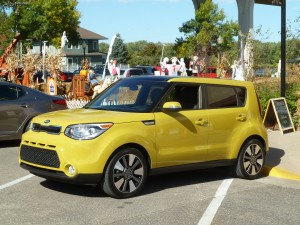
Bright new colors, more planted stance,interior upgrades, direct-injection engines improve Soul for 2014.
By John Gilbert
The hamsters are back, bobbing their heads in trendy rhythm as they avoid more humdrum vehicles that insist on sharing the roadways with the Kia Soul, and it’s a welcome and comforting cast that has become as trendy as the little square car itself. Almost.
Revised and upgraded engines, with gasoline direct-injection in both the base 1.6 and upgraded 2.0-liter 4-cylinders, plus revised and improved suspension systems for better stability and handling, and a stiffer platform with lighter and stronger body components, makes for a deceptively improved driving experience. The first Soul was neat and trendy; the 2014 model is neat, trendy, and significantly improved as a driver’s car.
Over its five-year lifespan, the Soul has become bigger than even Kia imagined, and the revised 2014 model proves Kia has finally maneuvered around to take advantage of its trendiness. For example, Kia picked Minneapolis as the site for introducing the new Soul, because Minneapolis seems to be the hot ticket in surveys of trendy places to live and visit. The introduction was held at the trendy Graves 601 Hotel, which is across the street from the legendary First Avenue nightclub made trendy as an enduring music venue by Prince, an iconic hometown hero.
Such symbolism, and the similar but longer-wider-more-refined car itself, indicates the remarkable popularity of the Soul can only increase with the new generation.
Kia can be excused for questioning the Soul’s identity, and even its own during its whirlwind rise in popularity, which pretty well parallels the lifespan of the Soul. For example, even company executives were unable to provide a satisfactory answer to whether it should be “Kia,” or “KIA,” because the corporate logo of the South Korean automaker is in all cap letters. Similarly, Kia seemed uncertain where it stood back in December of 2008, when it introduced the somewhat bizarre squarish subcompact called the Soul.
At that time, at a fancy hotel on the Miami coastline, the Soul had to share the spotlight with Britney Spears, who was shielded from the masses by an entourage of security forces and policemen trying to protect the budding media star. And we mean Ms. Spears, not the new little square car from Kia. However, in the five years since, it’s anybody’s guess which one’s identity has proven more popular and enduring, but that’s another story.
The original Soul introduction made media stars out of some weird little furry cartoonish hamsters, using them liberally as a bopping bunch of critters rhythmically driving along in traffic in the ad campaign. Obviously, the intent was to try to lure a younger batch of customers, but Kia seemed unsure and maybe even embarrassed that its tangential move might be going too far. At subsequent car introduction, officials even apologized, saying not to worry, there would be no more hamsters. I argued with company executives that the hamsters were not only a clever and memorable symbol, but the furry critters might be more iconic than the car itself. It took time, but the hamsters returned. Read more
Mazda3 for 2014: A Car for Any Year
By John Gilbert
The 2014 Mazda3 is a quick and agile compact that has a distinctive flair and the ability to change directions instantaneously — much like its namesake company.
In an automotive world dominated by companies large enough to resemble cruise ships, Mazda is more like a speedy runabout, able to change directions almost immediately. A year ago, Mazda introduced its CX-5, a newly engineered compact SUV holistically built from the ground up to Mazda’s just-revealed Skyactiv technology. The vehicle impressed all who drove it or looked at it, and it finished as runner-up to the revised Ram 1500 in the North American Truck/Utility of the Year competition.
That was just the tip of the Skyactiv iceberg, and the company has followed up with an impressive midsize sedan makeover for the Mazda6. And now it has produced the compact Mazda3.
The result is that both the Mazda3 and Mazda6 are among the candidates on the short list for the 2014 North American Car of the Year award. In a year where the candidate list is filled with flashy sports cars, luxury sedans, sporty sedans, and economy cars, and even its larger sibling, the Mazda3 concedes nothing, and its technology, appearance and performance mean it must be seriously considered by all jury members who drive it.
The full list of car candidates voted onto the short list is, in alphabetical order: the BMW 4 Series, Cadillac CTS, Chevrolet Corvette Stingray, Chevrolet Impala, Infiniti Q50, Jaguar F-Type, Kia Cadenza, Lexus IS, Mazda3, Mazda6, Mercedes-Benz CLA, and the Toyota Corolla. In addition, truck/utility candidates are: Acura MDX, BMW X5, Buick Encore, Chevrolet Silverado, GMC Sierra, Hyundai Santa Fe LWB, Jeep Cherokee, Kia Sorento, Land Rover Range Rover Sport, Nissan Rogue, Subaru Forester, and the Toyota Tundra.
Some of the car candidates are priced well over $50,000, and even over $75,000. That also has to work in favor of the Mazda3, which has a price range of $16,945 for the most basic I-SV model with a stick shift, and it ranges upward to $18,445 for the I-Sport, $19,595 for the I-Touring, and up to $22,745 for the I-Touring with technology and GT packages. The same models with the 2.0 and 6-speed automatic is about $1,000 more all the way up. The 2.5-liter engine comes only with the automatic, in either S-Touring at $24,595 or the S-GT at $25,995. Read more


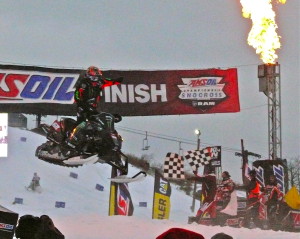
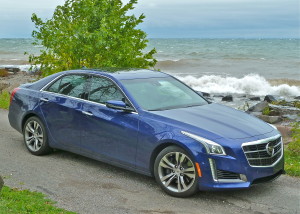
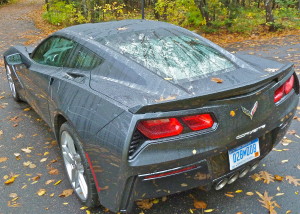
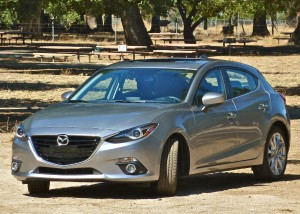

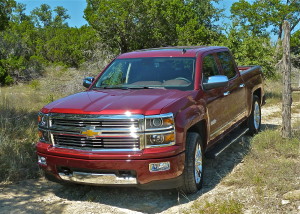

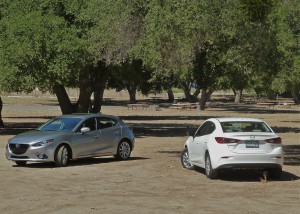
 John Gilbert is a lifetime Minnesotan and career journalist, specializing in cars and sports during and since spending 30 years at the Minneapolis Tribune, now the Star Tribune. More recently, he has continued translating the high-tech world of autos and sharing his passionate insights as a freelance writer/photographer/broadcaster. A member of the prestigious North American Car and Truck of the Year jury since 1993. John can be heard Monday-Friday from 9-11am on 610 KDAL(www.kdal610.com) on the "John Gilbert Show," and writes a column in the Duluth Reader.
John Gilbert is a lifetime Minnesotan and career journalist, specializing in cars and sports during and since spending 30 years at the Minneapolis Tribune, now the Star Tribune. More recently, he has continued translating the high-tech world of autos and sharing his passionate insights as a freelance writer/photographer/broadcaster. A member of the prestigious North American Car and Truck of the Year jury since 1993. John can be heard Monday-Friday from 9-11am on 610 KDAL(www.kdal610.com) on the "John Gilbert Show," and writes a column in the Duluth Reader.